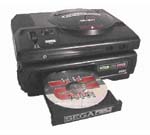 Development of the Sega CD was top secret.
Development of the Sega CD was top secret.
Programmers did not know
what was being designed until the system was unveiled at the Tokyo Toy
Show in Japan.
Upon release, companies were told to start with "high
memory"-based cartridge games and work from there (add cinemas, CD-
music, FMV, etc., later).
The Sega CD was designed to take on the PC
Engine (TurboGrafx-16) CD unit, and NOT the SNES.
The key factor to the
Sega CD's design was that engineers based it somewhat on the PCE-CD, but
with MORE memory and a slightly faster drive (6 Mbits and 150k transfer
rate at 0.8 access time).
The original Mega-CD was released in Japan in (June 1991?), and was
developed to compete with NEC's PC Engine CD-ROM drive (equivalent to
the TurboGrafx-CD in the U.S.).
The machine was released with the
following titles in Japan:
Earnest Evans, Woodstock Funky Horror Rock
Band, ... etc.
The system was initially a hit in Japan, due to the CD
based RPGs (!) and the inherent advantages of CD-based titles (lots of
text, pics, animation, CD-based music, etc.).
Lunar: Silver Star was
one of these and helped sell the system during slow sales periods.
The Mega Drive (Genesis) is mounted to the Mega CD (Sega CD) unit
through the interface slot on the right side, and rested on top of it.
On the front loading model
the drawer is opened by hitting the
button, and closed by either hitting the pause button on
controller #1 or via the CD system software CLOSE command.
The Sega CD was released in November 1992 in the U.S. and looked very
much like the Japanese Mega CD counterpart.
Several pack-in titles were
included:
the Sega Classics 4-in-1 CD (Shinobi, Columns, Streets of
Rage, and Golden Axe),
Sherlock Holmes I,
Sol Feace,
and two CD+G/music
CD samplers.
The original selling price was $299. (The second U.S.
production run after the initial 50,000 units had the Sega Classics
5-game CD instead of the four-game CD above - see CDX)
These were the Sega CD titles available at the time of launch:
Cobra Command
Night Trap
Black Hole Assault
Sewer Shark
Chuck Rock
INXS Make Your Own Music Video
Marky Mark Make Your Own Music Video
Initial hype resulted in incredible sales. There were 50,000 units
originally allotted in early November for the US launch.
ALL the units
were sold by the third week (prior to Thanksgiving).
The second run
began arriving in stores December 1992, approximately three days before
Christmas.
In (1994) Sega released a new, smaller Genesis and had a Sega CD II to
go with it.
This model connected to the Genesis and sat (somewhat) side
by side with it.
Discs are loaded into the top of the unit, through a
manually-opened door.
Several third-party developers had signed on to do Sega, including Sony
Imagesoft, Vic Tokai, Konami, Data East, EA Sports, Psygnosis, Working
Designs, and many others. All in all, 148 titles were produced for the
U.S. market.
The early Sega CD titles were packaged inside a cardboard box with the
instructions, and CD in a regular jewel case inside.
(Examples include
WonderDog, Jaguar,
all the "Make My Video" titles except C+C Music
Factory) In 1993, Sega of America began packaging them in large plastic
jewel cases, about 8-1/4" by 5-3/4" and about 3/4" thick.
These are the
same jewel cases used by Saturn games and some older Playstation titles.
Note that Sega of Japan continued to use regular-sized jewel cases for
all Mega CD games, with small instructions to fit inside, just like a
music CD.
* Production runs for the Sega CD (original model) ended in 1993
* Production runs for the Sega CD2 ended in December 1995, in order
to increase the production of the Saturn
* Total number produced: officially - ???
- Unofficial estimate: 2.5 million, U.S., 2 - 3 million, Japan, 1
million, Europe.
Big thanks to Barry Cantin for letting me use a ton of info for the site.
